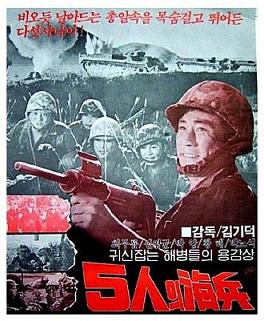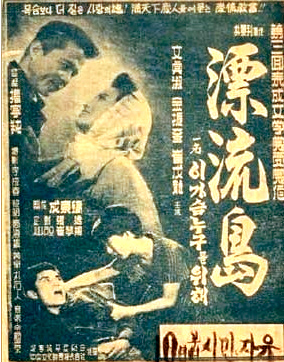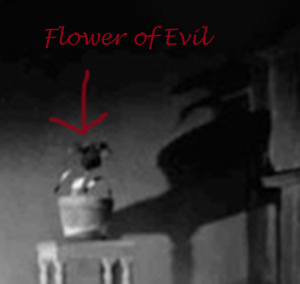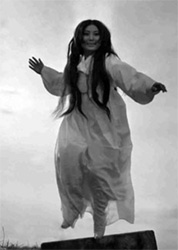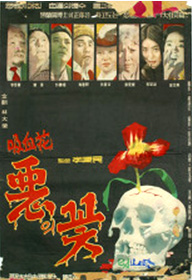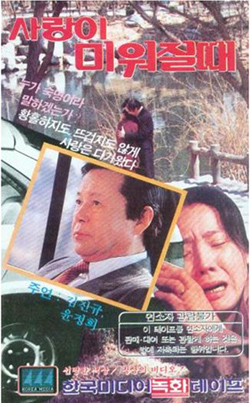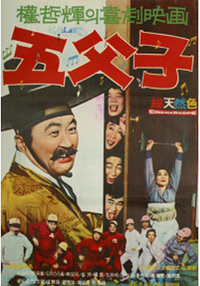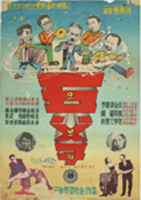Not all monsters, ghosts and things that go bump in the night are from horror films. Today’s entry onto the list of Obscure Monsters comes from the children’s fairytale, The Brothers Heungbu and Nolbu directed by Kang Tae-woong in 1967.
Before introducing our feature guest today, I should probably talk a little about the movie. The Brothers Heungbu and Nolbu was the first feature length film made in Korea to be performed entirely by claymation and dolls not unlike classic holiday favorites such as Rudolph the Red-Nosed Reindeer and Santa Clause is Coming to Town. This Korean movie was also made for a holiday, May 5th. No, not Cinco de Mayo– Children’s Day! In the movie, Heunbu’s hoarde of children sing a happy-ish song while animals and birds play together with them–I think this is right before a huge snake appears and attempts to devour the baby birds still in the nest. The happy-ish song is a nice change for the kids. Most time when they are onscreen, they are sobbing about how hungry they are and how sorry they are for their parents. While much time is spent on the kids, the story is really about the kind Heungbu who, along with his wife and children, savagely beat the snake to death. During the battle, one of the birds suffers from a broken leg. Heungbu and family take care of it and are rewarded by the birds with a magic seed. In the film, when the seed grows, it produces three enormous gourds that Heungbu and his wife saw open. In one gourd are jewels, silks and luxurious clothes. In another gourd are piles of gold and coins. The final gourd transforms the family’s hovel into a palace-like home. And then comes the good part…
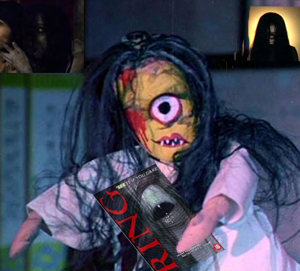 Heungbu’s brother is the scene stealing Nolbu and his evil wife. Whenever these two are on screen, the movie is more interesting. These two are very wealthy and care nothing for Heungbu and his prodigious family. When Heungbu goes to them to beg for food for his starving family, Nolbu’s wife slaps him upside the head with a spoon full of rice and tells him he can keep whatever stuck to his face. However, seeing that his younger brother is much wealthier than he, Nolbu becomes jealous and learns how his brother came upon such good fortune. Finding a swallow, he first ‘accidently’ breaks the birds leg and then goes about taking care of it to ensure he too will receive a magic seed. However, his gourds are cursed. From the first gourd emerges a talking tiger that chases the couple through their home and warns them to stop their greedy ways. Not heeding the warning, the couple goes to open the second gourd. A huge dragon appears in a puff of smoke. Although terrifying it wanders away without harming them. But in the final gourd, our star appears– the One-Eyed Ghost! With her entrance, all hell breaks loose. The cyclopsean spirit of vengence chases Nolbu’s wife around, eventually biting her in the neck with her fangs while Nolbu is chased by the tiger and the dragon returns to crush and burn their home to the ground. The movie has a happy ending with Nolbu and his wife going to live with Heungbu and his family. And here to say a few words about her role in the movie is the One-Eyed Ghost herself!
Heungbu’s brother is the scene stealing Nolbu and his evil wife. Whenever these two are on screen, the movie is more interesting. These two are very wealthy and care nothing for Heungbu and his prodigious family. When Heungbu goes to them to beg for food for his starving family, Nolbu’s wife slaps him upside the head with a spoon full of rice and tells him he can keep whatever stuck to his face. However, seeing that his younger brother is much wealthier than he, Nolbu becomes jealous and learns how his brother came upon such good fortune. Finding a swallow, he first ‘accidently’ breaks the birds leg and then goes about taking care of it to ensure he too will receive a magic seed. However, his gourds are cursed. From the first gourd emerges a talking tiger that chases the couple through their home and warns them to stop their greedy ways. Not heeding the warning, the couple goes to open the second gourd. A huge dragon appears in a puff of smoke. Although terrifying it wanders away without harming them. But in the final gourd, our star appears– the One-Eyed Ghost! With her entrance, all hell breaks loose. The cyclopsean spirit of vengence chases Nolbu’s wife around, eventually biting her in the neck with her fangs while Nolbu is chased by the tiger and the dragon returns to crush and burn their home to the ground. The movie has a happy ending with Nolbu and his wife going to live with Heungbu and his family. And here to say a few words about her role in the movie is the One-Eyed Ghost herself!
Won-ai: Hiya folks!
Me: So what can you tell me about your part in the Brothers Heungbu and Nolbu?
Won-ai: Well, first let me tell you that I hated the ending. It was very different from the original story!
Me: What do you mean? I have seen a lot of children’s books with this story in it. They are all pretty much the same.
Won-ai: Those are the modern versions. They are way too soft on Nolbu. They have thieves or goblins or winds coming out of the gourd to deprive him of his wealth. In the original versions he got a good beating and covered with excrement! Nolbu’s wife isn’t in the original stories either. He was unmarried and carried with him a bag of perversity.
Me: Bag of perversity? Do they have those at E-Mart?
Won-ai: You don’t want one. The bag made him do evil and disgusting things like pee in the well or stuff dung into the mouths of crying babies or use other men’s wives if they owed him money. He was a terrible person and derserved what he got!
Me: You seem to be getting angry just talking about him. We can change the subject…
Won-ai: Sorry. I’ve been holding onto my han for so long that it sometimes gets the better of me.
Me: Your han?
Won-ai: Sure. How do you think I became a ghost? or anyone else becomes a ghost for that matter?
Me: Umm… you died?
Won-ai: Yes, I died. But I died with a great han. Han is a Korean concept deeply rooted in traditional thought. There is no single word to describe it in English ‘though it is often translated as ‘grudge’ or ‘resentment’ or ‘regret.’ It is the feeling from putting up with oppression in silence or being helpless to help someone you love. It is having to forgive when you really don’t want to and the sorrow of never being able to express how you really feel.
Me: Really? So anyone can feel han?
Won-ai: Well, nine times out of ten it is applied to women. I read an article in the LA Times this past January where they talked about a man shopowner in LA carrying han, but I found it very odd. Ask any Korean around you and they will tell you that han is generally used to refer to something a woman feels–her supressed emotions that she is not allowed to express. Some researchers also say that it is part of the national psyche because of the long history of invaders in Korea through the centuries. In horror movies, it is almost always the thing that motivates the vengence of a female ghost. Korean horror movies through the years have had titles like Resentment of a Daughter-in-Law, My Sister’s Regret, Wol-nyeo-s Grudge… I could go on and on.
Me: I see. Now I know why you are a ghost. But what about the one eye? Is that natural?
Won-ai: Nah, this is my scary face. In the movie you might notice that I sometimes have two eyes. Ghosts can change. In the movie Public Cemetary of Wol-nyeo the ghost appears as a beautiful mother, a floating light and a toothy demon. I can be quite pretty when I want to be.
Me: I noticed you are carrying something. A DVD of the Japanese movie Ring? Why do you have that?
Won-ai: I just took this along to show you that my scary, one-eyed look is not unique in film. Not only Ring, but if you look behind me in the picture above, you will see an image from the Japanese movie Ju-on and the Korean film Face on the wall behind me. Modern horror also makes use of the baleful, giant eye.
Me: Yeah, I see it. Come to think of it, you do look a lot like the ghost from Ring…
Won-ai: What! I’m from 1967! Ring was made in 1998! If anything she looks like me! But y’know, I can’t claim to be the first long-haired ghost wearing white either. Horror movies from the 60s and possibly earlier are filled with us. Sadako was NOT the first contrary to what many Western articles and bloggers have to say. She was just the next in a long line of ghosts. She wasn’t even the first one to come popping out of a well! The ghost in Shin Sang-ok’s Ghost Story of the Joseon Dynasty lived in a well and that was made in 1970. I’ll give Sadako the climbing through the tv bit though…that was pretty good… Then again, I came out of a gourd fresh off the vine. I’d like to see her try that!
Me: Well, that is all the time I have today. I want to thank our guest for the day, One-Eyed Ghost, and congratulate her on being the featured Obscure Monster on our Countdown to Halloween. See you tomorrow!


